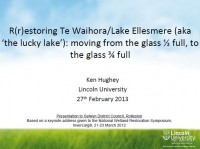Management
Joint Management Plan
The lake is subject to a Joint Management Plan between the Department of Conservation and Te Runanaga o Ngai Tahu. This is a statutory plan which aims for integrated management of the natural and historic resources in the plan area, for Mahinga Kai and conservation purposes.
Monitoring, drain management, reserve management
The Canterbury Regional Council is responsible for water-quality monitoring in the lake and tributaries, pest management, and maintaining a system of drains in the Halswell Drainage District. The Selwyn District and the Christchurch City Councils manage networks of drains and lakeside recreation reserves and are responsible for the protection of natural resources in their districts.
Lake opening
The lake is opened mechanically approximately three times a year to manage for a range of values, including wildlife, wetland vegetation and fish habitat, mahinga kai, customary fisheries, water quality, summer levels, land inundation, waterway networks and infrastructure, and fish migration for a variety of species in Autumn and Spring. Lake opening criteria are set by a National Water Conservation Order and by resource consents under the RMA, which include research projects on the effects of lake-opening, and consultation with interested parties.
Water Conservation Order
The Water Conservation Order application was first lodged in 1988, and the accompanying report sets the out reasons why the Lake was considered outstanding for wildlife habitat, particularly for waterfowl and wading birds.
In December 2010 the Department of Conservation and Ngai Tahu applied for a variation to the existing Water Conservation Order which, amongst other things, proposed that further categories of outstanding feature be added.
A hearing in May/June 2011 to consider submissions resulted in recommended changes to the National Water Conservation Order (WCO). Environment Canterbury accepted these recommendations and forwarded them to the Minister for the Environment. The changes were gazetted in August 2011 and are effective from September 22, 2011. The current WCO can be read here.
Current Resource Consent for Lake Opening
The Hearing Commissioners decision on the new joint resource consent application by Te Runanga o Ngai Tahu and Environment Canterbury was received on Wednesday 22 January 2014. The decision was to grant the application for a period of 15 years subject to a suite of mitigation measures. You can read the decision here.
Research reports (2014)
One of the conditions of the current resource consent is the preparation of reports on the research and monitoring undertaken as a condition of the resource consent. Copies of the reports can be obtained from Environment Canterbury:
1: Results of coastal erosion monitoring for previous 12 months
2: Results of in-lake monitoring for previous 12 months
3: Results of the off-shore monitoring for previous 12 months
4: A programme for monitoring the effects of coastal plume
5: Proposal: investigation on summer Lake Levels
6: Information on openings for last 12 months. Note: a mechanical closure has never been attempted so is not part of the dataset.
Restoring Te Waihora – a presentation
In February 2013 Ken Hughey, WET Trustee and Professor of Environmental Management at Lincoln University, presented to Selwyn District Council on the management of the Lake. The presentation was similar to ones given at the 2012 National Wetland Symposium and the 2012 WET AGM and can be seen here.
The 2006 decision by Hearing Commissioner Dr Brent Cowie on current Lake opening protocols can be found here.

